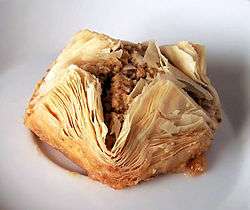Filo
Filo or phyllo is a very thin unleavened dough used for making pastries such as baklava and börek in Middle Eastern and Balkan cuisines. Filo-based pastries are made by layering many sheets of filo brushed with oil or butter; the pastry is then baked.
 Baklava, made with filo pastry | |
| Alternative names | Filo pastry, phyllo, fillo |
|---|---|
| Type | Pastry |
| Main ingredients | Flour dough |
History
The origin of the current practice of stretching raw dough into paper-thin sheets is highly debated, unclear and unknown. Many credit the origins of Filo as far back as antiquity. Ancient Greeks would bake thin breads sweetened with walnuts and honey, arguably the ancestor to Baklava. The first documented such food may have been written in Homer's Odyssey written around 800 B.C.[1] In the fifth century B.C. Philoxenos states in his poem "Dinner" that, in the final drinking course of a meal, hosts would prepare and serve cheesecake made with milk and honey that was baked into a pie.[2]
The 11th century Dīwān Lughāt al-Turk by Mahmud Kashgari records the meaning of yurgha, an archaic term for yufka, as "pleated or folded bread". (Yufka is the Turkish language term for filo, as well as for a kind of thin unleavened bread.)[3] The mention of filo is documented in the Topkapı Palace during the time of the Ottoman Empire.[4]
Ultimately many historians will cite that the origin is not definitive but rather the dough has been an evolution over the various ages between many cultures and peoples.
Preparation
Filo dough is made with flour, water and a small amount of oil.[5] Homemade filo takes time and skill, requiring progressive rolling and stretching to a single thin and very large sheet. A very big table is used, preferably with a marble top. If the dough is stretched by hand a long, thin rolling pin is used, with continual flouring between layers to prevent the sheets from sticking to one another.[3] In modern times, mechanical rollers are also used. Prior to World War I, households in Istanbul typically had two filo makers to prepare razor thin sheets for baklava, and the relatively thicker sheets used for börek. Fresh and frozen versions are prepared for commercial markets.[3]
Use
When using filo to make pastries, the thin layers are made by first rolling out the sheets of dough to the final thickness, then brushing them with oil, or melted butter for some desserts, and stacking them. This contrasts with puff pastry and croissant doughs, where the layers are stacked into a thick layer of dough, then folded and rolled out multiple times to produce a laminated dough containing thin layers of dough and fat.
Filo can be used in many ways: layered, folded, rolled, or ruffled, with various fillings.
List of filo-based pastries
- Baklava – A Greek/Turkish dessert with layers of filo with chopped nuts, sweetened and held together with syrup or honey.
- Banitsa – A Bulgarian dish consisting of eggs, cheese and filo baked in the oven.
- Börek – A savory filo pie originally from the Ottoman Empire.
- Bougatsa – A type of Greek breakfast pastry.
- Bülbül yuvası – A Turkish dessert with pistachios and syrup.
- Bundevara – A Serbian sweet pie filled with pumpkin.
- Galaktoboureko – A Greek dessert consisting of filo and semolina custard.
- Gibanica – A Serbian dish made from filo, white cheese, and eggs.
- Kasseropita – A Greek pie made from filo and kasseri cheese.
- Pastizz – A savory pastry from Malta filled with ricotta or mushy peas.
- Spanakopita – A Greek spinach pie.
- Strudel – Filo wrapped around a filling such as cooked, sweetened apple pieces.
- Tiropita – A Greek dish similar to Börek, filled with a cheese-egg mixture.
- Zelnik – A savory pie from the Balkans.
Name
The English term comes from the Greek: φύλλο which means leaf.[6][7]
A popular Albanian dish called flia, or fli, may have been an early form of filo. In Albanian, fije/fli translates as both "sheet" and "leaf" (pl. flete/gjethe) just like φύλλο in Greek.
The Turkish name yufka means both the thin dough used for baklava and börek, and a kind of flatbread, also called sac ekmeği, cooked on a sac, a domed metal plate.[8] In Arabic countries filo is called reqaqot.[3]
See also
References
- Mayer, Caroline E. "Phyllo Facts". Washington Post. 1989.
- Hoffman, Susanna. The Olive and the Caper. Workman Publishing Company, Inc. ISBN 9781563058486
- Helou, Anissa (2015). Sweet Middle East: Classic Recipes, from Baklava to Fig Ice Cream. Chronicle Books. p. 73.
- Perry, Charles. "The Taste for Layered Bread among the Nomadic Turks and the Central Asian Origins of Baklava", in A Taste of Thyme: Culinary Cultures of the Middle East (ed. Sami Zubaida, Richard Tapper), 1994. ISBN 1-86064-603-4
- Marks, Gil (2008). Olive Trees and Honey: A Treasury of Vegetarian Recipes from Jewish Communities Around the World. Houghton Mifflin Harcourt.
- Oxford Dictionaries.
- Alan Davidson (2014). The Oxford Companion to Food. Oxford: Oxford University Press. ISBN 978-0-19-967733-7. p. 307.
- Türk Dil Kurumu, Büyük Türkçe Sözlük search form Archived 2015-05-15 at the Wayback Machine
Bibliography
- Perry, Charles. "The Taste for Layered Bread among the Nomadic Turks and the Central Asian Origins of Baklava", in A Taste of Thyme: Culinary Cultures of the Middle East (ed. Sami Zubaida, Richard Tapper), 1994. ISBN 1-86064-603-4.
- Engin Akın, Mirsini Lambraki, Kosta Sarıoğlu, Aynı Sofrada İki Ülke: Türk ve Yunan Mutfağı, Istanbul 2003, ISBN 975-458-484-2.
External links


